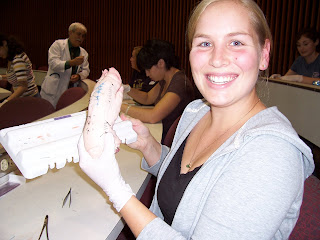
So I’ve spent a lot of time explaining (complaining) about all of the science classes and tests and studying I’ve been doing for the last three months, but I haven’t spent much time talking about the more medically-related things I’ve gotten to do. In many ways, these are the things that keep me going as they sneak into my schedule just frequently enough to remind me what all of this is about and why I’m ultimately there. Here’s a little summary of three that have been the most notable for me.
Standardized patients: In the last post I talked about our Clinical Decision Making class that tries to encompass all of the non-science parts of being a doctor. One part of this has been learning to interact with patients. I should qualify this by explaining that they aren’t dumb enough to let completely untrained students see real patients. Instead it’s like they let us play doctor. This includes a Clinical Skills Center that looks just like a regular doctor’s office complete with waiting and exam rooms, and “standardized patients” who are actors given various ailments to present to us. (Yes, like that “Seinfeld” where Kramer pretends to have gonorrhea.) So far we haven’t actually been allowed to touch the patients, but that starts in a couple weeks. For now, we’ve been working on techniques for interviewing patients and eliciting a complete medical history. I’m sure this sounds boring, but I’ve been quite excited. Plus, they let us dress up in our white coats and everything, so we feel super official. (I told you it was like playing doctor…)
Anatomy lab: Last week we started Block 2, which includes Gross Anatomy Lab (appropriately called “gross lab”). This means we started work with the cadavers we’ll be dissecting and studying for the next few months. I can’t do this experience justice in the paragraph I’m planning to write right now, but suffice to say that it’s incredible and incredibly overwhelming all at once. We are lucky to work in groups of just 4 students per cadaver, which allows each of us to really appreciate each structure and take part in dissections. As a learning tool, this is invaluable, and lab follows right with our lectures of the different body sections / systems. So far we have dissected the back, shoulder, and axilla (armpit – believe it or not there is a crazy network of nerves and vasculature in there!). Next up: upper arm, forearm, and hand. It can be a little strange to spend so much time with dead bodies (and the smell permeates you and isn’t great), but we have adjusted pretty quickly. I’m sure I’ll have lots of stories to share as we go along, but for now I would be completely remiss if I didn’t recognize the amazing gift these people gave by donating their bodies to our program. We’re all so thankful to them and their families – even if it does result in me spending hours in our basement gross lab.
Suturing workshops: This is the closest I’ve gotten to doing “real doctor things” since I got here, and it’s made me really excited (as evidenced by the fact that many people have probably already heard about this ad nauseum). The first was a basic suturing workshop in which we learned four different stitches (interrupted, vertical mattress, horizontal mattress, and running – you can see them all in the pictures!) on straight, smooth-edged incisions. We learned proper instrument usage and knot tying. There were a number of physicians that came to help us all practice and to give us tips. My friend Lara was there with me, and we judged the night a huge success as we were not told by a doctor, as one of our classmates was, “Hmmm… maybe you should just consider psychiatry.” We were able to continue to hone our skills a few weeks later when we attended an advanced suturing workshop. This one assumed mastery of the basic skills (which we clearly had) and taught more specialized techniques. We learned all sorts of cool stitches and how to work with non-ideal wounds (those that aren’t straight, don’t close evenly, etc.). I received the biggest compliment of my nascent career when the physician looked at a particularly tricky closure I had completed and declared, “Looks like you’ll have a career in Plastics if you want it!” While I have no interest in Plastic Surgery and he was likely just being nice, I was (and still am) thrilled by the comment. I guess I should acknowledge (as is evident in the pictures) that our unwilling experimental patients were pigs’ feet. However, I really want a live, human patient to practice on… and as a result I’ve taken to encouraging my friends to do reckless things and then assuring them I’ll take care of it if they need some stitches! Unfortunately, I don’t think they appreciate my skills as much as the indulgent doctors do.


2 comments:
Seinfeld shout-out!!!
Cool doctor things too, I guess.
btw -- that pig stitching looks SO gross! haha
Post a Comment